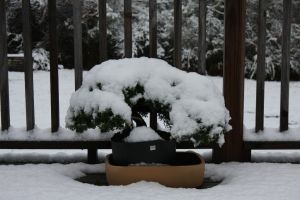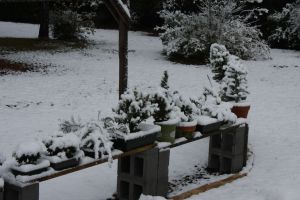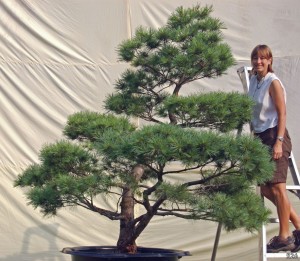In most areas of the country, snow is simply a part of winter. In the South, however, it *may* come once per year and most of the time that doesn’t stick to the ground. We had a really good snow this year though, and for some of my bonsai, it was their first time to deal with it. We got about 4 inches a few weeks ago (yes, I’m just getting around to blogging about it), but even with that much, it was gone by lunch. Nevertheless, here’s some pictures.
Author: sbonsai
Bonsai Bench
Bonsai Bench is a well put-together site that let’s users input care information for plant varieties used for bonsai. It’s an excellent concept and needs more user interaction to cover all the different varieties and zones that exist. If you have experience in bonsai and would like to contribute care information for a specific variety, I’d encourage you to do so. Hopefully, beginners will be able to use the site to find their tree in their zone and get specific information on the best times to prune and feed.
http://www.bonsaibench.com/
Air Layering Resources
Bonsai Bark did a nice series in the past couple of months on air-layering. If you have mature yard trees, a well-developed branch you need to remove, or would like the chance to start over with your nebari, then air-layering is definitely something to look into. Here’s the links:
A Simple Air-layering Technique Part 1
A Simple Air-layering Technique Part 2
A Simple Air-layering Technique Part 3
Here’s an explanation of the process and why it works over at EverGreen Garden Works: What is Air Layering?
Some other resources:
Layering Techniques for Bonsai
Airlayering by the Texas Agriculture Extension Office
If you have any other resources about air layering and it’s relationship with bonsai, send me the links and I’ll add them to this post.
Plant City Bonsai
On a recent trip to Atlanta, I visited many places that you’ll probably hear about in upcoming posts, but the highlight was a trip to Clermont, GA to talk with Steve Cratty at Plant City Bonsai. He took the time to talk with me about almost every aspect of his bonsai stock and even helped me choose a fine specimen to take home (which I’ll talk about in the future). Plant City Bonsai has many specimens, but most of the stock is for beginner bonsai artists like myself that is a step above nursery material so that your only choices aren’t a $10 5 year old tree and a $500 30 year-old tree. Steve tries to fill that gap with material that is already started on it’s way to being a good bonsai, but still leaves you plenty of creative control over what the final look will be. I found the experience to be very enjoying and sorry that I missed Warren Hill, who was appearing there the next day. I’ve included some pictures of my visit, and sadly, did not video the tour that he gave me. This is definitely a labor of love with Steve and I got that hint that it may have given him a few gray hairs along the way 🙂
Fall is here
Highs this week are in the low 80’s signifying the end of the really hot temps that we’ve seen all summer here. Some of my trees are slowly coming back to life with some fall growth like the boxwoods, junipers, and even some late growth on my crape myrtles. Not all of my bonsai made it through the summer though, with this azalea struggling for the past 3 months and finally giving up the fight in the past month or so. I have repotted trees in almost every month of the year, but got entirely too brave with this repot. I repotted during the flowering period, put it in too shallow of a pot, and there was just too much of the root system above the soil line. I started out with sphagnum moss covering the top part of the root system, but it kept that part too wet. The other part stayed way too dry due to the soil being about 80% turface. I guess you could call this a progression picture, but it’s certainly not progression in the right direction.It’s an understatement to say I still have much to learn about the art of bonsai.
Shin-Boku – Japanese Garden Trees
This site is really amazing and something I was reading about at Stone Lantern’s Blog called Bonsai Bark. Shin-Boku Nurseries create specimen garden trees and the images are incredible. If a person wasn’t standing beside the tree, I would think it was a bonsai, and I guess technically, it is.
Help me ID this tree!
If you have ever needed to ID a bonsai that: wasn’t correctly labeled, didn’t have a label at all, or that you collected, then help might be a click away. If your an experienced bonsai artist, you may be able to help others ID their plants. MyPlantID.com
My Plant ID began in January 2008 as a plant identification service. People from all over the world sent us photographs of their plants and we identified them for free. The demand was overwhelming. When we realized that we couldn’t keep up with the amount of daily submissions, we knew something had to change. At the same time, there was a large number of plant enthusiasts who contacted us, eager to help identify. The result is http://www.myplantid.com. With you help and curiosity, we hope to build myplantid into the premier plant identification website and forum.
Features:* Identify plants online.
* Search by leaf features (arrangement, shape, margin, vein) and location.
* Submit plant image and let users identify it.
* Organize and keep track of all your garden plants online .
* Contribute by identifying plats of others.
* Registration required, free.
Jim Smith Bonsai
Orlando Bonsai had a post on it’s blog today about Jim Smith’s Bonsai nursery. This nursery has been providing wholesale bonsai material since 1979. If your wife is looking for a beach location and your wanting to do a little scouting on the side, check out Vero Beach, Florida so you can swing by Jim Smith’s.
My Bonsai RSS Bundle
I have created a Google Reader RSS bundle for those that like to read Bonsai blogs. If you click the link below, then subscribe to this bundle (you’ll need a Google or GMail account), then you will automatically subscribe to the 33 bonsai blogs that I have been able to find in Google Reader. Just go to http://www.google.com/reader to read the updates every day. Here’s the link: Google Reader Bonsai Bundle
If you use another reader, here is the OPML file to import: Bonsai Blogs OPML File
By the way, I have been having problems with my RSS feed. It showed errors if you looked at it in Google Reader or Feedburner. If you received a lot of updates in your RSS reader today, this is why.
My 2nd Costa Farms Bonsai
My 2nd Costa Farms bonsai, which some would refer to as mallsai, has turned out to be one of my favorite trees in my collection. People love the S-curve even though most bonsai artists would call it boring and unimaginative. The first bonsai I purchased is much like this (and also a Ficus Retusa) and will be something I will stay motivated to maintain no matter how good or bad it looks. I love the low-maintenance and toughness of the Ficus Retusa species. It stands up to the heat of the South and my beginner mistakes, not to mention that it grows quickly. I have a tough time finding Ficus Retusa or Tigerbark Ficus trees in my area, and I never know what I’m going to get online unless I’m prepared to pay over $100 for a finished bonsai. So, the latest aquisition is again another Ficus Retusa that I found at Wal-Mart with interesting movement (again, in my opinion). Here it is:




